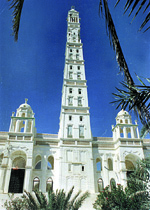
A Tour of Hadramout [Archives:2000/22/Culture]
May 29 2000
By Aden Burea Staff

Historians have reported that there had been a very ancient kingdom which consisted of several colonies. It continued from 1000 B.C until 4 A.D. Most of the colonies were located on mounds called “Akmah”. On top of these, castles were built around which houses, public squares and markets were located. Usually, these colonies were situated on valley’s passages. One of the most famous of these colonies is “Kashkaash” which lies on top of a mountain near Karat Aal Thabit village. Ruins have also shown that people living during that age had small water canals branching from Al’Ayn valley.
Souran Colony
This colony was mentioned in the ancient inscriptions of Sheba kingdom in Adiah Bin Affan village. This colony lay on the trade route and contained a prosperous trade center in 1000 A.D.
Hayouda Colony
This colony is located in an area named Al-Sadeed, to the north of Saioon. The colony consisted of several houses around which were built a wall to protect them.
The ancient civilization of Hadramout was economically very strong. The inhabitants carried out a flourishing trade in perfumes and incense which, at the time, were very important objects used in the ancient Greek temples. As far as forms of worship are concerned, ancient people in Hadramout worshiped idols and planets. One very famous temple has been discovered which is named “Sein” (God of the moon). In addition, it has been discovered that they were burying a person’s tools and equipment with his body when he was dead.
Shibam: City of First Skyscrapers in the History
Shibam which is an ancient historical city named after its King “Shibam Bin Al-Hareth Bin Hadramout”. This city was first mentioned in the Mosnad inscription. Al-Hamadani stated in his book that it is the biggest city in Hadramout and that it has 300 mosques. Part of the city was destroyed by the “Kinda” tribe which colonized the city and made it their capital. The city is surrounded by a big wall and it has also got the oldest skyscrapers in the world. These buildings are named “The Mud Civilization” which consists of adobe covered with limestone. The tallest buildings reach a height of 30-40 meters with 15 to 16 floors.
During the Islamic rule, Hadramout was the center of the revolution against the rule of Bani Omayah. This movement was called “Al-Abyadyah” after its leader Abdullah Bin Yahya Al-Kindi who was an “Abadi” Imam.
Al-Shahar
This city lies on the southern coast of Yemen between Aden and Oman. The city was given this name after its inhabitants. Those latter would gather in the early dawn “Al-Sahar” and therefore called Al-Sahareeon. This city is known for its numerous wells and palm trees.
Al-Ahkaf
Al-Ahkaf is a very famous historic district and was mentioned in the Holy Qur’an. In fact, there is one full Sura that is called “Al-Ahkaf” where the story of Prophet Hood (Peace be upon him) is mentioned. Nowadays, many people visit this city where the grave of Prophet Saleh (Peace be upon him) is located.
Tarim
Tarim is one of the cities of Wadi Hadramout and is located to the north of Shibam. It was given this name after Tarim Bin Al-Sokoon Bin Al-Ashras Bin Kindah. The city was built by Tarin Bin Hadramout Bin Saba. This city has lots of mosques, one of which is Tarim Mosque which is one of the most famous mosques in the Arab World. This city also contains Al-Barakah Grave meaning “Blessed Grave” where 40 martyrs of Badr battle, originally from Tarim, were said to be buried.
First Arab Maritime Institute
When the Yemen land trade started to decay during the rule of Al-Himyariah, the Yemeni people thought that there must be a way to travel through sea just as people in Egypt have done. So, a new era began and maritime cities such as Al-Shahar, Aden and Al-Maka flourished.
Until the late 1900s, Al-Hami city in Hadramout remained the first school on the coast of the Arab Sea to develop sails. Many people came to learn marine sciences from the people of this city. One of the most famous sailors was Ahmed Bin Majed who was originally from Sour, Oman. This great sailor wrote a book which summarized the sailing experiences and knowledge in this field spanning 4000 years. This proves that Arabs started sailing several centuries B.C. Arab sailors discovered the sailing theory and were the first to use the seasonal wind to cross thousands of miles in the sea using their small triangular sails.
The maritime trade played a great role in developing the civilization of Hadramout. However, despite all the different cultures including Indian, Indonesian and African that it transacted business with, Hadramout has maintained its distinctive identity. Until this day, people of Hadramout have preserved their traditions such as folklore dance and songs.
——
[archive-e:22-v:2000-y:2000-d:2000-05-29-p:./2000/iss22/culture.htm]


